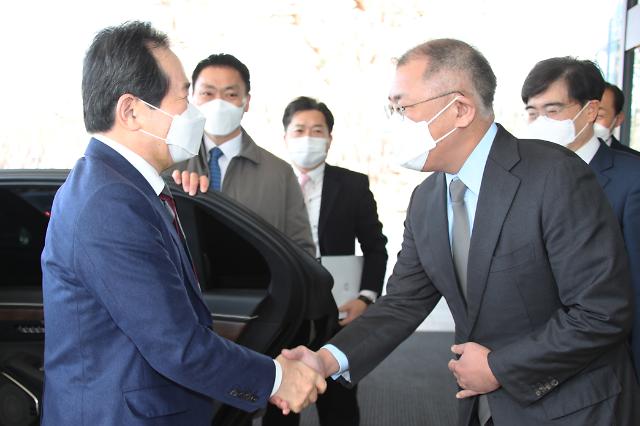Supply of 7.85 million eco-friendly cars by 2030
Secure price competitiveness by introducing battery-less business

Prime Minister Jeong Sye-gyun (left) greets with Hyundai Motor Group Chairman Eui-sun Eui-seon while attending a state affairs inspection and coordination meeting held at Hyundai Motor’s Namyang Technology Research Center in Hwaseong-si, Gyeonggi-do on the 18th. [연합뉴스]
The government will supply 7.85 million eco-friendly cars and reduce greenhouse gas emissions by 24% by 2030. It is a calculation that it will expand the market of eco-friendly cars, a new growth engine, and take care of carbon neutrality at the same time.
Prime Minister Jeong Sye-gyun held the 122nd National Policy Review and Coordination Meeting at Hyundai-Kia Motors’ Namyang Research Center in Hwaseong-si, Gyeonggi-do on the 18th, and discussed the ‘4th Basic Plan for Eco-friendly Vehicles’. At the event, Eui-seon Eui-sun, chairman of Hyundai Motor Group, looked at support plans together and held a test drive for the electric car’Ioniq 5′.
The domestic eco-friendly car market increased from 240,000 units in 2016 to 820,000 units last year. As for exports last year, electric vehicles ranked 4th in the world and hydrogen car distribution ranked 1st in the world. However, it is pointed out that the charging infrastructure is insufficient to operate the current eco-friendly car, and the high price is a problem.
Accordingly, the government prepared the 4th Basic Plan for Eco-Friendly Vehicles, which contains strategies to foster eco-friendly vehicles by 2025. The main goal of this plan is to secure an eco-friendly vehicle infrastructure and supply 7.85 million units by 2030.
To this end, public institutions are obligated to purchase 100% eco-friendly cars. The private sector introduces an eco-friendly car purchase target system. The charging infrastructure is also planned to increase to more than 500,000 units, which is 50% of the number of electric vehicles supplied by 2025. The supply of ultra-fast chargers that can travel 300km with a 20-minute charge is also in full swing.
In the case of hydrogen cars, 450 units will be built by 2025 so that they can reach charging stations anywhere in the country within 30 minutes. In particular, the plan is to be concentrated in Seoul and the metropolitan area, where charging stations are scarce.
The ecosystem is also being reorganized to secure price competitiveness of eco-friendly cars, which has been steadily pointed out. The government has built a dedicated platform for eco-friendly vehicles, lowering the vehicle price by more than 10 million won, and introducing a battery lease business to induce the initial purchase price to less than half of the current price.
The government also proposed the goal of becoming a powerhouse in exporting eco-friendly cars. By improving vehicle performance, it plans to increase exports of the current 280,000 units to 830,000 units by 2025. The share of exports will also increase from 14.6% to 34.6%.
The launch of fully self-driving cars is aimed at by 2024, and the six core parts are advanced. The all-solid-state battery, which is illuminated as a next-generation secondary battery, is planned to be commercialized by 2030.
In the case of hydrogen cars, commercial vehicles will be released in the full vehicle class by 2025, and durability and mileage will be significantly improved. In addition, by 2030, 1,000 parts companies will be converted into companies related to the future car industry, accelerating the transition to a carbon-neutral industrial ecosystem.
Prime Minister Jeong said, “Even amid rapid changes in the automobile industry, it can be an opportunity for Korea to leap forward as a leader in the automobile industry,” and “Let’s strengthen capabilities and adapt to changes through solidarity and cooperation between the government and companies.”
©’Five Languages Global Economic Daily’ Ajou Economics Prohibition of unauthorized reproduction and redistribution
